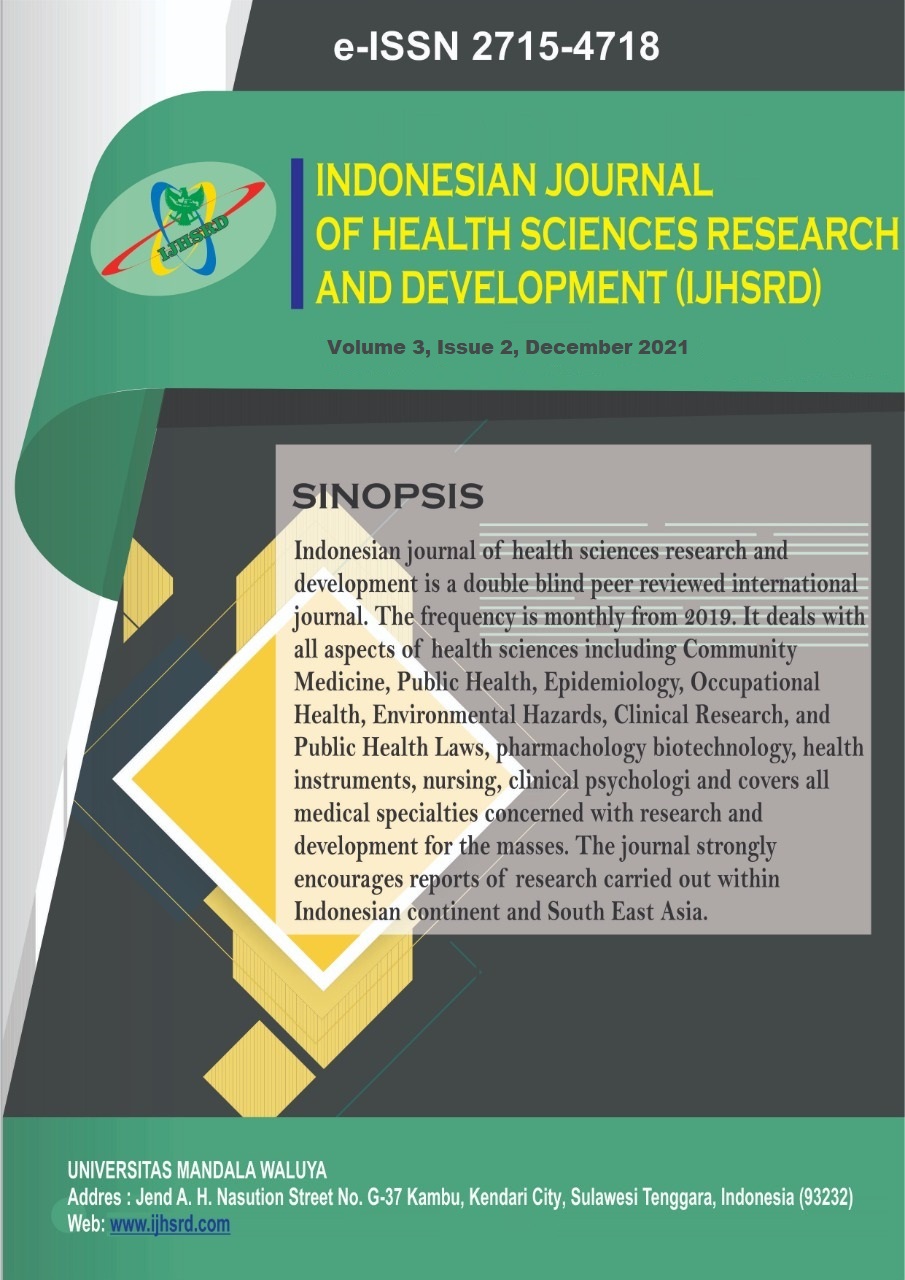Main Article Content
Abstract
Background: The prior study for 20 students in Public Middle School 1 Pasikolaga showed that 16 students (32.8%) experienced dysmenorrhea, 3 students (1.46%) often experienced dysmenorrhea and 1 student never experienced dysmenorrhea. The objective of this study was to analyse the risk factor of stress and history of allergy to dysmenorrheal in adolescent students in Public Middle School 1 Pasikolaga.
Methods: Quantitative research with analytical method with case control study design. The research location is Public Middle School 1 Pasiokolaga, Muna Regency, Southeast Sulawesi. The population of all students from class VII to class IX is 205. The number of samples is 134 with a sampling technique usingstratified random sampling.
Result: The results of data analysis obtained the value of Odds Ratio (OR) = 1.568, this means that stress with the incidence of dysmenorrhea has a 1.56 times greater risk of developing dysmenorrhea compared to respondents who do not have stress and the value of Odds Ratio (OR) = 1.459, this means history of allergy with dysmenorrhea has a risk of 1,459 times the occurrence of dysmenorrhea compared to respondents who do not have a history of allergies.
Conclusion: Stress and history of allergies are risk factors for the incidence of dysmenorrhea in public of female students1 Pasikolaga.
Keywords
Article Details

This work is licensed under a Creative Commons Attribution-ShareAlike 4.0 International License.
References
- Rahmawati DM, Isnaeni Y, Sholihah AN. Risk Factors for Primary Dysmenorrhea in Adolescents at SMA Muhammadiyah 5 Yogyakarta City in 2018. 2018.
- Ervina A. The Effect of Diversity of Food Types on the Incidence of Dysmenorrhea. Journal of Obstetrics Scientia. 2015;3(1).
- Indonesian Ministry of Health. Basic health research. Jakarta, Head of the Health Research and Development Agency of the Indonesian Ministry of Health. 2013.
- Purba EPN, Rompas S, Karundeng M. Relationship between Knowledge and Behavior in Handling Dysmenorrhea at middle public 7 Manado. Nursing Journal. 2014;2(2).
- Diana S. 1 The Relationship between Stress and Primary Dysmenorrhea in Medical Students, Faculty of Medicine, Andalas University: Andalas University; 2013.
- Hendrik H. Menstrual problems: An overview of Islamic law and medicine: The Triumvirate; 2006.
- Kurniawati D, Kusumawati Y. The effect of dysmenorrhea on activity in vocational school students. PACKAGE: Journal of Public Health. 2011;6(2).
- Notoatmodjo S. Health Research Methodology, Rineka Cipta. Jakarta, Indonesian. 2010.
- Ismail IF, Kundre R, Lolong J. The Relationship between Stress Levels and the Incidence of Dysmenorrhea in Semester VIII Students of the Nursing Science Study Program, Faculty of Medicine, Sam Ratulangi University, Manado. Nursing Journal. 2015;3(2).
- Yulianingsih R. The Relationship Between Fast Food Consumption And Physical Activity With The Nutritional Status Of Adolescents At Sma N 1 Baturetno Wonogiri: STIKES PKU Muhammadiyah Surakarta; 2017.
- UTAMI NH. The Effect of Sanyinjiao Point Acupressure (Sp6) on Reducing Primary Dysmenorrhea Pain.
- Hawari D. Holistic Approach to Mental Disorder: Schizophrenia, 3rd edition. Jakarta: Publishing Agency, Faculty of Medicine, University of Indonesian. 2012.
- PRINCESS RC. The Relationship Between Nutritional Status, Family History, And Exercise Routine With The Incidence Of Dysmenorrhea In Middle Class XI Students 08 Pontianak: Faculty of Health Sciences; 2019.
- Nuraini S, Sa'diah YS, Fitriany E. Relationship between Menarche Age, Nutritional Status, Stress and Hemoglobin Levels on the Incidence of Primary Dysmenorrhea in Medical Faculty Students, Mulawarman University. Journal of Science and Health. 2021;3(3):443-50.
- Jayadipraja EA, Prasetya F, Azlimin A, Mando WOSY. Family clean and healthy living behavior and its determinant factors in the village of Labunia, Regency of Muna, Southeast Sulawesi Province of Indonesia.Public Health of Indonesia. 2018;4(1):39-45.
